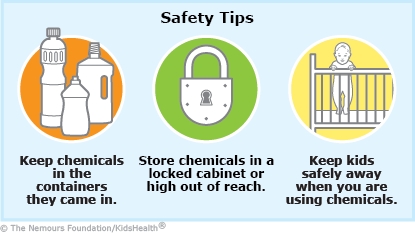After Swallowing Bleach: How to Care for Your Child
Kids who swallow bleach may have nausea, vomiting, and belly pain. If they drink a lot of it or if it's industrial-strength bleach, they may also irritate their mouth and esophagus (the tube that connects the mouth to the stomach). Because bleach tastes bad, most kids don't drink enough of it to do serious damage. If they breathe in the bleach fumes, they may have some coughing.
The health care team checked your child for any problems and treated them, if needed. Your child is now ready to go home. This is a good time to review how to prevent poisonings.



Your child has:
-
trouble swallowing, won't drink, or is drooling (these can be signs of damage to the mouth or esophagus)
-
nausea, vomiting, belly pain, or coughing for more than 24 hours

Your child seems to be getting sicker or has trouble breathing.

How can I prevent poisonings at home? Be sure to:
-
Store these products where kids can't reach them (in a locked cabinet, if possible):
-
cleaning products (including laundry and dishwasher detergents)
-
car supplies (antifreeze, windshield washer fluid)
-
gardening products (fertilizer, bug repellent)
-
pest poisons
-
nicotine products (like cigarettes and e-cigarette products)
-
alcohol
-
medicines (both prescription and those you can buy without a prescription)
-
batteries
-
Keep cleaning products in their original bottles. Never put them in empty food or drink containers.
-
Store cosmetics and toiletries (such as perfume, hair dye, hairspray, shoe polish, nail polish, and nail polish remover) where children can't reach them.
-
Keep children away when you use chemicals (for example, when spraying pest killers).